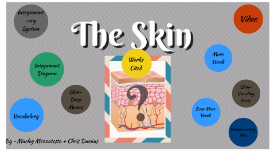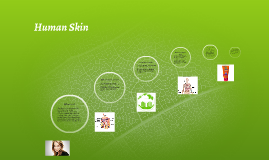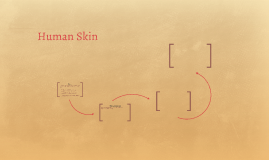Human skin
Transcript: The Human Skin By Susu Bedawi The website I used was: All about the human skin You might be surprised but the human skin is the bodys biggest organ! You may not think of the skin being an organ but the skin is very importent. It covers and protects everything inside your body. Without skin , Peoples muscles, bones and organs would be hanging all over the place! Skin holds eveything together. It also: Protects our bodys Helps our bodys stay at the right temperature Allows us to have a sence of touch Layers The Skin is made up of three layers. Epidermis Dermis Subcutaneous The Epidermis Look down at your hands for a minute. Even though you can't see anything happening your epidermis is hard at work. At the bottem of your epidermis new skin cells are forming. When the cells are finally ready, they start moving towards the top of your epidermis. This trip takes about 2 weeks to a month. As newer cells continue to move up older cells near the top die and rise to the top of your skin. What you see on your hands [ and everywhere else on your body] are really dead skin. Bye Bye Skin Cells The old cells are tough and strong just right for covering your body and protecting it. But they only stick around for a little while. Soon they'll flake off. Though you can't see it happening, every minute of the day you lose about 30,000 to 40,000 skin cells of the surface of our skin. So just in the time you've listened to my presentation so far you've lost about 40,000 cells! But don't think your skin might wear out someday. Your epidermis is always making new skin cells that rise tothe top to replace the old ones. Most of the cells in your epidermis [ 95% ] work to make new skin cells. And what about the other [ 5% ]? They make a substance called Melanin. Melanin gives skin its colour.The darker your skin is the more Melanin you have. When you go out into the sun, these cells make extra melanin to protect you from getting burned by the suns ultra violet, or UV, rays. Thats why your skin gets tan if you spend alot of time in the sun. But even though melanin is very strong, it can't shield you all by itself. You'll want to wear sun cream and protective clothing. Protecting your skin now can also help provent skin cancer when you get older. Dermis The next layer down is the Dermis. You can't see your dermis because it's hidden under your epidermis.Inside the dermis there are nerve endings, blood vessels, oil glands, and sweat glands. Glands are like little pockets with liqids in them. The dermis also contains collagen and elastin, which are tough and streachy. Nerve system The nerve endings in your dermis tell you how things feel when you touch them. They work together with your brain system , so that your brain gets the message about what your touching. Sometimes what you feel is dangerous, so the nerve endings work with your muscles to keep you from getting hurt. If you touch something hot the nerve endings in dermis respond right away: 'Ouch! Thats hot!!!' The nerves quickly send a message to the brain, which then immeditly commands the muscles to take your hand away. This all happens in a split second , without you ever thinking about it. Subcutaneous The third bottom layer of the skin is called the subcutaneous layer. It is made mostly fat and helps your body stay warm. This layer is where you'll find the start of the hair, too. Each hair on your body grows out of a tiny tube in the skin called follicle. Every follicle has its roots way down in the subcutaneous layer and continues up through the dermis. You have follicles all over your body, exept on your lips, the palms of your hands and the soles of your feet. Did You Know You have more than 100,000 follicles on your head alone!!!!!! If you haven't been feeling so well for the last few days , and you've had a runny nose and a cough. Then one morning you wake up and stumble into the bathroom and look in the mirror and yikes! You have the chiken pox! Chicken pox is caused by a virus called Varicella zoster. People who get the virus get a rash of spots all over there bodies. What Happenes when you get Chicken Pox? Chicken pox may start out seeming like a cold. You might have a runny or stuffy nose , sneezing, and a cough. But one to two days later , the rash begins, often in bunches of spots on the chest and face. From there it can spread out quickly over the entire body. Sometimes the rash can get inside a persons ears or mouth. How does Chicken Pox Spread? A person who has Chicken Pox can pass it to someone else by coughing or sneezing, When he or she coughs, sneezes, laughs and even talks, tiny drops come out of there mouth and nose. These drops are ful of Chicken Pox virus. It's easy for others to breath in these drops or get them on there hands. Before you know it the chicken pox virus has affected someone new. Itchy Itchy Scratchy Scratchy If you are that unlucky person, how do you keep your chicken pox from driving you crazy? They are very itchy but your not suposed

















